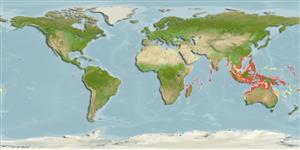分類 / Names
俗名 | 同種異名 | Catalog of Fishes(屬, 種) | ITIS | CoL | WoRMS | Cloffa
Elasmobranchii
板鰓亞綱 (鯊魚與魟魚) (sharks and rays) >
Carcharhiniformes (Ground sharks)
真鯊目 (Ground sharks) >
Carcharhinidae (Requiem sharks)
白眼鮫科 (Requiem sharks)
Etymology: Carcharhinus: karcharos (Gr.), sharp or jagged; rhinus, an ancient name for sharks, from rhine (Gr.), rasp, both words alluding to a shark's jagged, rasp-like skin. (See ETYFish); sealei: In honor of American ichthyologist Alvin Seale (1871-1958), Stanford University, who described this shark in 1910 but used a preoccupied name (C. borneensis). (See ETYFish).
Environment: milieu / climate zone / depth range / distribution range
生態學
海洋 礁區魚類; 深度上下限 0 - 40 m (Ref. 244). 熱帶; 24°N - 30°S
Indo-West Pacific: reported to occur throughout the area, from Kenya to Indonesia; north to China. Distribution west of the Indo-Malay Peninsual needs validation.
印度-西太平洋: 分散的來自東非到中國與澳洲的紀錄。 時常與 杜氏白眼鮫〔Carcharhinus dussumieri〕 互相混淆而且時常有被歸類於 Carcharhinus tjutjot 與 黑印真鯊〔Carcharhinus menisorrah〕 .
Length at first maturity / 大小 / 重量 / 年齡
Maturity: Lm 71.5, range 68 - 75 cm
Max length : 100.0 cm TL 雄魚/尚未辨別雌雄; (Ref. 3678); 84.6 cm TL (female)
A small species which is distinguished by the following characters: snout moderately long and bluntly pointed; upper anterior teeth oblique and blade-like, coarsely serrated laterally, lateral margin deeply notched and with several large and smooth basal cusplets; lower anterior teeth narrower, slightly oblique, lateral margins usually not notched and with several large basal serrae, mostly smooth; total tooth row 24-28/22-27 or 47-55; interdorsal space often without a ridge on midline, 19.0-22.4% TL; first dorsal fin is moderately tall and falcate, origin about opposite pectoral-fin free rear tip, length 14.7-16.0% TL, 1.3-1.7 times height, inner margin 2.1-2.7 in base; second dorsal fin is much smaller, broadly triangular, height 31-37% of first dorsal fin height, its origin slightly posterior to anal-fin origin; anal fin falcate, height 0.9-1.2 times second dorsal height, base 1.0-1.3 times second dorsal-fin base; body colour pale brownish to grey dorsally, whitish ventrally; second dorsal fin with a black blotch covering most of fin and often extending slightly onto upper surface of body, usually diffuse-edged and poorly defined from ground colour of fin; other fins are plain or with pale outer margins; total vertebral 146-163; monospondylous precaudal 42-48; diplospondylous precaudal 26-38; diplospondylous caudal 74-81; precaudal 71-82 (Ref. 89954).
一種小的, 細長的鯊魚有一個長的, 圓形的吻又大的, 橢圓形的眼, 與斜尖的齒; 第二背鰭鰭有包含的鰭的一半或更多,其他的鰭平原的顯著的黑色頂端。 (參考文獻 5578) 淺灰色或背面灰褐色的, 腹面白色的; 在第二個背鰭上的黑色的斑點.(參考文獻 9997)
Found on the continental and insular shelves, from the surf line and intertidal region to deeper water (Ref. 244). Feeds on small bony fishes (including sea horses), prawns, and squid (Ref. 9997). Viviparous (Ref. 50449). Specimens caught with size ranging from 37.0-67.4 cm TL were found to be immature, males apparently begin to mature around 71.0 cm TL and birth size is between 32.0 and 37.0 cm TL (Ref. 89954). Often caught by shore anglers (Ref. 5485). Utilized as a food fish (Ref. 244).
棲息於大陸棚與島嶼棚, 從碎浪區與潮間帶的區域到較深的水域了。 (參考文獻 244) 吃小的硬骨魚類 (包括海洋馬) ,蝦與烏賊。 (參考文獻 9997) 胎生的.(參考文獻 50449) 時常被岸釣者釣獲。 (參考文獻 5485) 作為食用魚.(參考文獻 244)
Life cycle and mating behavior
成熟度 | 繁殖 | 產卵場 | 卵 | 孕卵數 | 仔魚
Viviparous, with a yok-sac placenta; 1-2 pups per litter (Ref. 244); after a gestation period of ~ 9 months(Ref.58048). 33-45 cm TL at birth (Ref. 9997). Distinct pairing with embrace (Ref. 205).印度-西太平洋: 分散的來自東非到中國與澳洲的紀錄。 時常與 杜氏白眼鮫〔Carcharhinus dussumieri〕 互相混淆而且時常有被歸類於 Carcharhinus tjutjot 與 黑印真鯊〔Carcharhinus menisorrah〕 .
White, W.T., 2012. A redescription of Carcharhinus dussumieri and C. sealei, with resurrection of C. coatesi and C. tjutjot as valid species (Chondrichthyes: Carcharhinidae). Zootaxa 3241:1-34. (Ref. 89954)
人類使用
漁業: 商業性; 游釣魚種: 是的
更多資訊
參考文獻養殖養殖資訊品種遺傳學Electrophoreses遺傳率疾病加工NutrientsMass conversion
合作者照片Stamps, Coins Misc.聲音神經毒速度泳型鰓區Otoliths腦重體重比眼睛色素
工具
特別的報告
下載 XML
網路資源
Estimates based on models
Preferred temperature (Ref.
123201): 24.9 - 29.1, mean 28.2 °C (based on 1150 cells).
Phylogenetic diversity index (Ref.
82804): PD
50 = 0.5000 [Uniqueness, from 0.5 = low to 2.0 = high].
Bayesian length-weight: a=0.00398 (0.00193 - 0.00820), b=3.08 (2.91 - 3.25), in cm total length, based on LWR estimates for this species & Genus-body shape (Ref.
93245).
營養階層 (Ref.
69278): 4.2 ±0.4 se; based on diet studies.
回復力 (Ref.
120179): 非常低的, 最小族群倍增時間超過14 年 (Fec=1).
Fishing Vulnerability (Ref.
59153): High vulnerability (60 of 100).
Nutrients (Ref.
124155): Calcium = 11.3 [2.2, 59.9] mg/100g; Iron = 0.466 [0.118, 1.294] mg/100g; Protein = 22.1 [19.4, 24.4] %; Omega3 = 0.109 [0.045, 0.251] g/100g; Selenium = 22.9 [6.0, 62.6] μg/100g; VitaminA = 72.1 [27.9, 181.4] μg/100g; Zinc = 0.669 [0.319, 1.284] mg/100g (wet weight);
